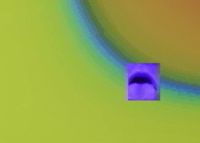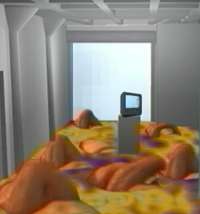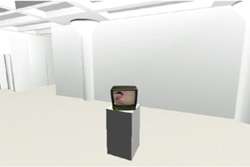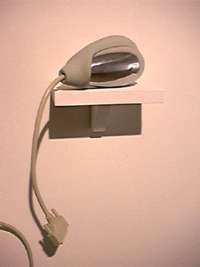Enough to Make You Sick
a multimedia video installation by Jack Stenner
| Enough to Make You Sick is a multimedia installation utilizing computer generated imagery, video and manufactured objects. The installation is composed of three primary elements; a large scale video projection, Consumption Junction - What's your function?; a pedestal mounted television, Lazy Susan, and several "objects". The goal of this exhibition is to communicate the essence of a society which continuously wants and never seems satiated; an environment which confuses reality, desire, objecthood and simulation. The work is not meant to offer any solutions or make any judgments about our choices, it is merely a reflection of the world I witness and, I hope it will allow us to smile as we recognize ourselves. If anything, the work is a self indictment of my own confused state. | ||||||||||||||||
 |
||||||||||||||||
|
Consumption Junction - What's your function? detail of wall projected video |
||||||||||||||||
| The video projection, Consumption Junction - What's your function?, addresses desire by presenting waves or streams of color which are consumed in a sequentially frenetic manner. The sequence begins with the focus on an object which consists of the leftover cellophane wrapping of an unidentified product. The product is tantalizing with its mesmerizing fractal imagery, but is soon consumed from within. Next we see what appears to be a blank wall and doorway. This is in fact the superimposition of a CAD representation of the gallery space. The doorway begins to shimmer with another pattern which is soon consumed as was the initial "product". As soon as one plane is consumed, another plane animates with color and seductive patterns of light and movement. Eventually, the wall plane itself is consumed and we behold a mirror image of the gallery itself. The walls, floor and openings of this superimposed representation of a representation are alternately consumed and animated. | ||||||||||||||||
 |
||||||||||||||||
|
Consumption Junction - What's your function? detail of wall projected video |
||||||||||||||||
| Within this false reality we can see the mirrored representation of a rotating television on a pedestal in the gallery. This TV rotates at a consistent rate throughout the presentation, while the animation of the walls accelerates. A soundtrack reinforces the concept by alternating original and "Muzak" versions of popular songs. The "copies" highlight the disparity and lack of understanding of the original versions. They represent the commodification that occurs in a mass market society and the superficial appreciation of art. | ||||||||||||||||
 |
||||||||||||||||
| The second element of the installation is entitled Lazy Susan. The viewer is invited to participate by following the computer generated view of the gallery space represented on the monitor as it rotates within the space. The image is periodically interrupted by "snow", or a large tongue consuming the screen. The principle idea behind this piece is the mindless, repetitive motion of consumption, and the superficial mimicry of reality. | ||||||||||||||||
|
Lazy Susan video still from rotating pedestal mounted television |
||||||||||||||||
| The third element is meant to communicate the artists willingness to participate is this "show". Three objects constructed of "computer appliance" gray plastic and chrome rest seductively on shelves with their functionless plugs dangling over the edge. Ripe for mass market production, these prototypes only need a market survey to establish their value. |
 |
|||||||||||||||
|
Model no. 10998 1
of 3 displayed |
||||||||||||||||
|
For the consumer in all of us: CD
ROMs with a "sick" screensaver (Mac only), Enough to Make You Sick VHS videotape also available. |
||||||||||||||||
| Events | Archives | Jack Stenner |
|
All work © copyright of the artist. Originally posted on 7/4/98; 7:41:26 PM, updated on 6/4/99; 6:00:16 PM Please contact the webmaster if you have website questions or problems. |